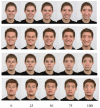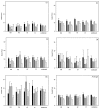Selectivity of face distortion aftereffects for differences in expression or gender
- PMID: 22319504
- PMCID: PMC3268253
- DOI: 10.3389/fpsyg.2012.00014
Selectivity of face distortion aftereffects for differences in expression or gender
Abstract
The perceived configuration of a face can be strongly biased by prior adaptation to a face with a distorted configuration. These aftereffects have been found to be weaker when the adapt and test faces differ along a number of dimensions. We asked whether the adaptation shows more transfer between faces that share a common identity, by comparing the strength of aftereffects when the adapt and test faces differed either in expression (a configural change in the same face identity) or gender (a configural change between identities). Observers adapted to expanded or contracted images of either male or female faces with either happy or fearful expressions, and then judged the perceived configuration in either the same faces or faces with a different gender and/or expression. The adaptation included exposure to a single face (e.g., expanded happy) or to alternated faces where the distortion was contingent on the attribute (e.g., expanded happy versus contracted fearful). In all cases the aftereffects showed strong transfer and thus only weak selectivity. However, selectivity was equal or stronger for the change in expression than gender. Our results thus suggest that the distortion aftereffects between faces can be weakly modulated by both variant and invariant attributes of the face.
Keywords: adaptation; aftereffects; face perception; facial expressions.
Figures









References
Grants and funding
LinkOut - more resources
Full Text Sources

